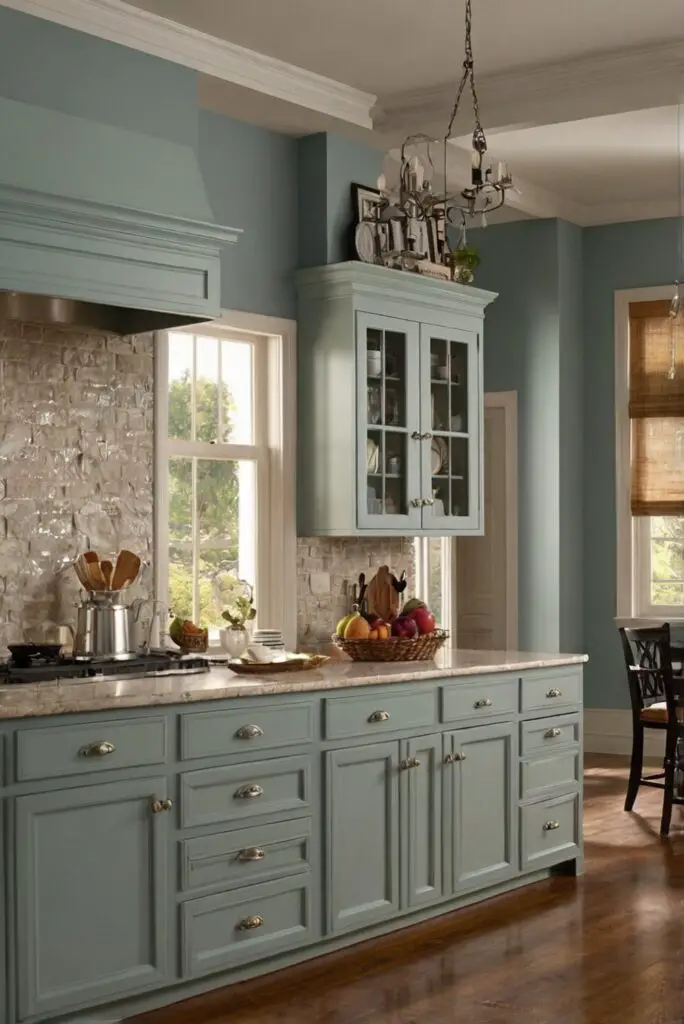Discover how selecting the right paint colors can enhance your kitchen’s natural lighting. Say goodbye to dull rooms!
How do you choose paint colors that complement your kitchen’s natural lighting?
As a daily routine with an interior designer:
When selecting paint colors for your kitchen, consider the natural lighting in the space. Lighter hues work well in kitchens with ample natural light as they reflect the light and make the room feel brighter and more spacious. If your kitchen receives minimal natural light, opt for warmer tones to add coziness. It’s important to test paint samples in different lighting conditions to see how they look throughout the day. Additionally, consider the color of your kitchen cabinets and appliances to ensure the paint color complements them harmoniously. A professional interior designer can provide expert advice on choosing the perfect color scheme for your kitchen based on your lighting situation and personal preferences.
How can I determine the natural lighting in my kitchen to choose the right paint colors?
My Lovely Spring Paint for 2025
Ready for a Spring Makeover? Explore the Freshest 2025 Paint Trends!
White Sage/Green SW Pistachio green Soft blue Honeysweet/Orange Pink Sugar Sage Tint BMAs an Amazon Associate, I may earn a commission from qualifying purchases at no extra cost to you.
To determine the natural lighting in your kitchen effectively, begin by observing the sunlight patterns across different times of the day. Consider installing a light meter or using a smartphone app to measure the intensity of light in various areas of the kitchen. Additionally, assess the direction of windows and the amount of direct sunlight that enters the space. This will help you understand the areas that receive the most natural light and those that may need additional artificial lighting or brighter paint colors to compensate.
Can I use light colors to brighten up a kitchen with minimal natural lighting?
Light colors such as white, cream, pale yellow, or soft gray can indeed help brighten up a kitchen with minimal natural lighting. These hues have reflective properties that bounce light around the space, creating a feeling of airiness and openness. Additionally, using light colors on walls and ceilings can make the room feel larger and more inviting. Consider pairing light-colored walls with darker accents or cabinets to add depth and contrast to the space.
What paint colors work best in kitchens with a lot of natural light?
Kitchens flooded with natural light can benefit from a wide range of paint colors. Consider cool tones like blues and greens for a refreshing and calming atmosphere or warm tones like yellows and oranges for a cozy and inviting feel. Neutral colors such as beige, taupe, or soft grays can also complement abundant natural light by providing a versatile backdrop for different decor styles. Experiment with sample swatches to see how the colors look under different lighting conditions before making a final decision.
How do I ensure the paint colors I choose complement my kitchen’s existing decor?
My fAV Spring DECOR for 2025
Discover Spring’s Best 2025 Decor Combinations – Perfect for Any Room!
Oversized Indoor Plants White Curved Sofas Rugs BOH Brown Cream Moroccan Hype Boho Rug Outdoor Patio Furniture Sets Topfinel Pillow CoversAs an Amazon Associate, I may earn a commission from qualifying purchases at no extra cost to you.
To ensure that the paint colors you choose complement your kitchen’s existing decor, take cues from the dominant colors in your cabinets, countertops, flooring, and appliances. Harmonize the wall colors with these elements by selecting shades that either blend seamlessly or create a striking contrast for visual interest. Consider creating a color palette that incorporates multiple hues from your kitchen’s decor to establish a cohesive and harmonious look. Remember to balance bold colors with neutral tones to avoid overwhelming the space.
Are there specific paint finishes that work best for kitchens with different levels of natural lighting?
In kitchens with ample natural light, opt for paint finishes like satin or eggshell, which have a soft sheen that reflects light and adds a subtle glow to the walls. These finishes are easy to clean and maintain, making them ideal for high-traffic areas like the kitchen. In contrast, kitchens with limited natural light may benefit from matte or flat finishes that create a cozy ambiance by absorbing rather than reflecting light. Consider the functionality and aesthetic appeal of different paint finishes based on your kitchen’s lighting conditions and maintenance preferences.
What are some alternative paint options that can complement natural lighting in a kitchen?
In addition to traditional paint colors, consider alternative options such as chalkboard paint, metallic finishes, or textured wallpapers to enhance the natural lighting in your kitchen. Chalkboard paint adds a playful and functional element to the space, allowing you to write recipes or grocery lists directly on the walls. Metallic finishes like gold, silver, or copper can reflect light and create a luxurious feel in a well-lit kitchen. Textured wallpapers in subtle patterns or natural motifs can add depth and visual interest to the walls while complementing the natural lighting in the room.
How can I organize the process of selecting paint colors to make sure they complement my kitchen’s natural lighting effectively?
Organizing the process of selecting paint colors for your kitchen involves creating a cohesive color scheme that harmonizes with the natural lighting. Start by gathering inspiration from interior design magazines, websites, or social media platforms to identify color palettes that resonate with your style and preferences. Create a mood board or digital collage to visualize how different colors will look in your kitchen and narrow down your choices based on the overall aesthetic you want to achieve. Consider consulting with a professional color consultant for expert advice on selecting paint colors that complement your kitchen’s natural lighting and existing decor.







